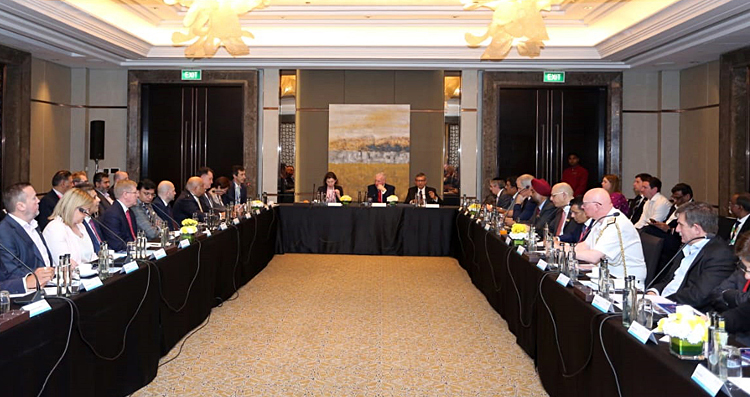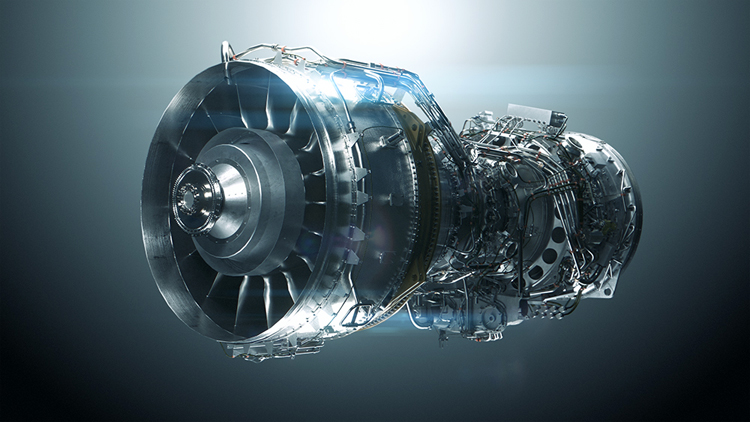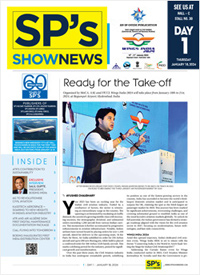- Prime Minister Narendra Modi inaugurates Aero India 2023 in Bengaluru; Releases Commemorative Stamp
- Defence Secretary meets delegations from Saudi Arabia, USA and Oman on the sidelines of Aero India 2023
- Foreign Ministers of 32 countries to attend Aero India 2023
- Embraer showcases the C-390 Millennium at Aero India 2023
Defence Secretary puts thrust on Aero-engine and Advanced Electric propulsion with UK
In a crucial development, Defence Secretary Rajesh Kumar Singh puts his policy thrust towards achieving this. In a bilateral meeting with Minister for the House of Lords, UK Lord Vernon Coaker on the sidelines of Aero India in Bengaluru, he laid out the key cooperation areas in Electric Propulsion.


India looks forward to speeding up the co-development of advanced military systems, especially the aero-engine and propulsion systems. In a crucial development, Defence Secretary Rajesh Kumar Singh puts his policy thrust towards achieving this. In a bilateral meeting with Minister for the House of Lords, UK Lord Vernon Coaker on the sidelines of Aero India in Bengaluru, he laid out the key cooperation areas in Electric Propulsion.
In line with the commitment during the Defence Ministers' Conclave, where Defence Minister Rajnath Singh called out the global community to join India in the co-development and co-production of advanced systems. The crucial Defence Ministers' Conclave proposed the co-development of 'Building Resilience through International Defence and Global Engagement (BRIDGE)', in Bengaluru on February 11. The Defence Secretary outlined innovative approaches & stronger partnerships to take such hi-stake development.
India's role and commitment extends beyond IOR and strives to serve as a blueprint for fostering global partnerships built on mutual respect, and adherence to international law.
Maritime has been the priority area within the security architecture of India. India's structured maritime concept builds upon the 'Security and Growth for All in the Region (SAGAR)' for the Indian Ocean Region (IOR), focussing on key areas such as maritime security, economic development, and blue economy. Further, India's role and commitment extends beyond IOR and strives to serve as a blueprint for fostering global partnerships built on mutual respect, and adherence to international law.
Co-development of the Electric Propulsion Systems
Last year, India and the UK signed a statement of intent (SoI) to cooperate in designing and developing Electric Propulsion Systems for the Indian Navy at Portsmouth in the UK.
While the discussion has been going on for some time, the progress took a firm shape during the meeting of the 3rd Joint Working Group on Electric Propulsion Capability Partnership (JWG EPCP) for the indigenous development of niche technologies.
The new -new-generation propulsion systems make crucial advancements for marine gas turbines embed with powerful electric cell-based designs which not only match the higher thrust but power for much longer and sustainable maritime mission.
The talks in the field of electric propulsion also make the case for the Indian Navy's second indigenous aircraft carrier (IAC-2) will be powered by an "integrated electric propulsion system," based on Rolls-Royce MT-30 gas turbines, which drives the Royal Navy's two aircraft carriers, HMS Queen Elizabeth, and HMS Prince of Wales. Here, the MT30 alternator also powers many global warships including the Navy's all-electric Zumwalt-class destroyers, the Italian Navy's future flagship, the Korean Navy's Daegu-class frigates, the Royal Navy's new Type 26 city-class frigates. Japan has also moved ahead with similar systems and packages to power their new 30 FFM frigates.
Largely, the majority of warships are of Russian and Ukrainian origin which also poses the supply chain issues besides the scale of technology – more towards conventional diesel-based mechanism.

The new -new-generation propulsion systems make crucial advancements for marine gas turbines embed with powerful electric cell-based designs which not only match the higher thrust but power for much longer and sustainable maritime mission. The system integrates electric motors, batteries, and advanced control systems to drive the vessel's propellers. Unlike conventional marine propulsion systems, which rely on internal combustion engines, electric propulsion offers several advantages, including lower emissions, reduced noise, and enhanced fuel efficiency.
In fact, the Indian Navy is pushing a great deal of deliberation for such tech infusion of full electric propulsion systems for the next generation of destroyers, frigates, corvettes, and landing platform docks (LPDs).
The Indian Navy is pushing a great deal of deliberation for such tech infusion of full electric propulsion systems for the next generation of destroyers, frigates, corvettes, and landing platform docks (LPDs).
Here, the key element is the Integrated Power Distribution. The Rolls-Royce electric propulsion system features a fully integrated power distribution network that manages the flow of energy from the battery bank to the electric motors. This ensures that power is delivered efficiently and reliably to the propulsion system, optimising the vessel's performance. The system can be integrated with other energy sources, such as fuel cells, to further enhance operational flexibility.
Additionally, for Battery Storage and Charging, the system uses high-capacity lithium-ion or other advanced battery technologies to store electrical energy. These batteries are capable of supporting long-distance voyages without requiring frequent recharging. For example, for battery storage, Rolls-Royce has designed the system to be compatible with shore-based charging infrastructure, allowing for convenient refuelling at port.
However, the most critical part in terms of military maritime missions is operational efficiency through the Advanced Control Systems. In this case, Rolls-Royce's electric propulsion system is supported by sophisticated control systems that enable operators to optimize vessel performance based on operational conditions. These systems monitor key parameters such as battery charge, motor speed, and energy consumption, allowing for real-time adjustments to improve fuel efficiency and reduce wear on mechanical components.
Electric propulsion systems are far quieter than traditional internal combustion engines, leading to a significant reduction in noise, making it ideal for operations in sensitive marine missions.
Furthermore, the Electric propulsion systems are far quieter than traditional internal combustion engines, leading to a significant reduction in noise, making it ideal for operations in sensitive marine missions.
Building on this, Defence Secretary Rajesh Kumar Singh also discussed the opportunities for Indian & UK defence companies to work together on ongoing and future joint projects.
Besides the UK, the Defence Secretary also held a bilateral meeting with the Under Secretary of State for Defence, Italy Matteo Perego Di Cremnago. They discussed ways & means to enhance the defence cooperation activities, including increased maritime and air exchanges, and joint project opportunities for Indian & Italian companies.
Manish Kumar Jha is a Consulting & Contributing Editor for SP's Aviation, SP's Land Forces and SP's Naval Forces and a security expert. He writes on national security, military technology, strategic affairs & policies.





